I’ve scraped this from commentator Montana Bound’s post on the most excellent shotgunworld.com, where it was attributed to a dead link. “All of these shots were taken from a known distance and angle into bare Ordinance Gelatin in a controlled environment. This does not take into consideration the effects clothing, weather, range, temperature, cover, or body structure.”
#8 Birdshot
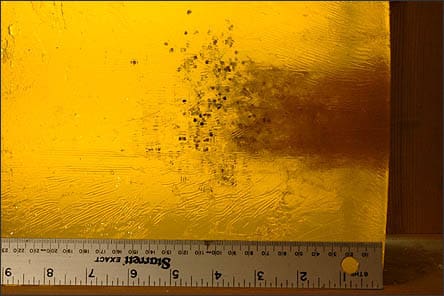
#8 Remington Heavy Dove out of an 18 inch barreled Remington 870 Marine Magnum
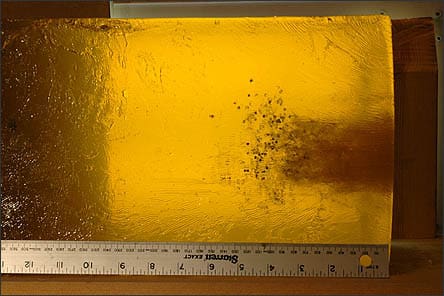
First three inches of permanent wound cavity were completely destroyed. Little to no temporary stretch cavity effects were observed.
Small sized birdshot such as this #8 heavy dove load is a poor choice for deployment with a tactical shotgun. Wounds inflicted from birdshot tend to be gruesome yet shallow as they lack the penetration required to reach vital cardiovascular or central nervous system structures.
#5 Birdshot
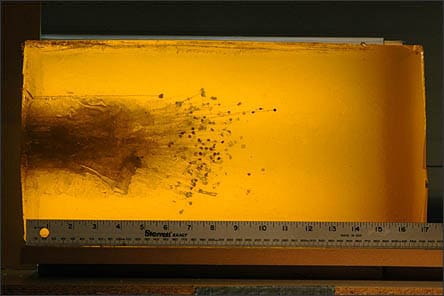
2¾ Kent Tungsten Matrix #5 Birdshot
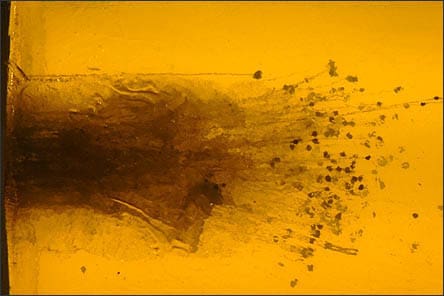
Closeup of the shot cloud and temporary stretch cavity.
The dark area on the left side of the photograph represents totally shredded gelatin.
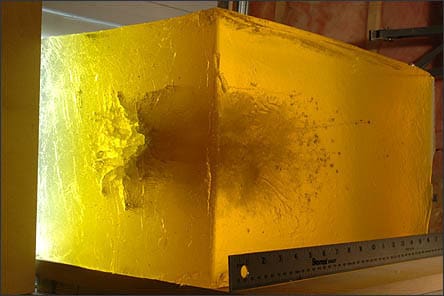
Shallow yet massively shredded entrance tract.
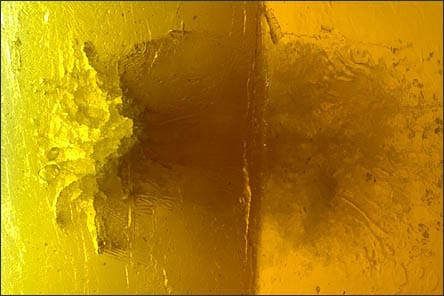
Entrance hole
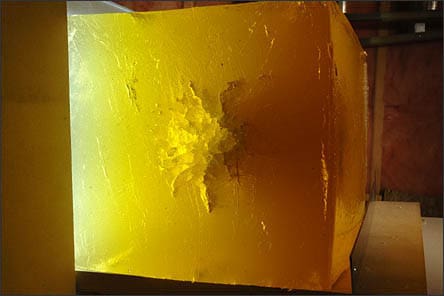
Entrance hole.
Designed as a better performing alternative to steel wetland bird loads, Tungsten Matrix is an exotic shotgun projectile material that has an even higher density than lead. It’s high density was what interested us in it’s possible application as a tactical shotgun load.
While this load’s penetration looks impressive as compared with the much larger #1 shot tungsten matrix load, it needs to be interpreted in the context of the calibration bb’s greater penetration. Temperature outside was a little warmer than it should have been when we shot this block and it was the last block of a relatively long string. As a result, this gelatin block exhibits slightly more elasticity than our standard blocks and consequently deeper penetration.
Small sized birdshot such as this #5 Tungsten Matrix load is a poor choice for deployment with a tactical shotgun. Wounds inflicted from birdshot tend to be gruesome yet shallow as they lack the penetration required to reach vital cardiovascular or central nervous system structures.
#4 Birdshot
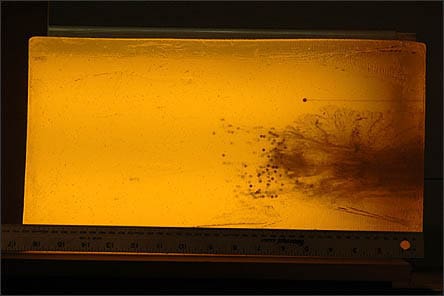
#4 Remington Heavy Dove out of an 18 inch barreled Remington 870 Marine Magnum
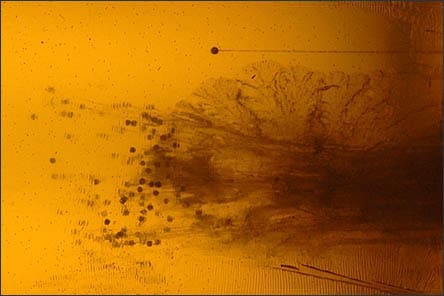
Significant crushing of tissue evident as with all birdshot, however minimal penetration limits the effectiveness of small shot as a tactical round except at ultra short range.
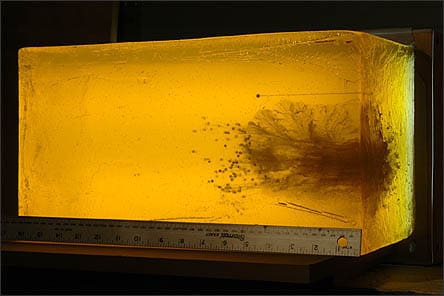
Perspective of the shredded gelatin block.

Slightly more perspective.
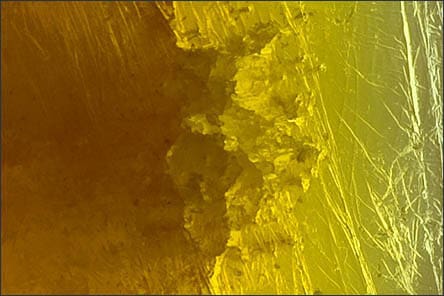
Closeup of the entrance “hole”.
Small sized birdshot such as this #4 heavy dove load is a poor choice for deployment with a tactical shotgun. Wounds inflicted from birdshot tend to be gruesome yet shallow as they lack the penetration required to reach vital cardiovascular or central nervous system structures.
#2 Birdshot
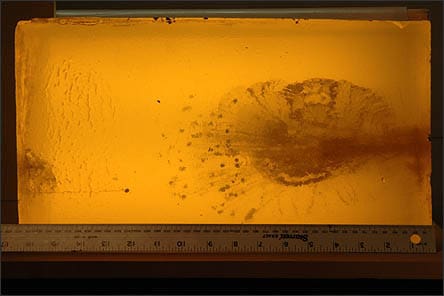
Remington Express #2 birdshot out of an 18 inch barreled Remington 870 Marine Magnum.
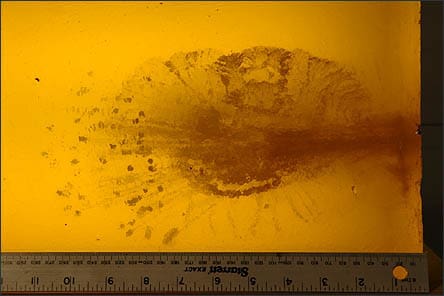
Average penetration of 9.5 inches was observed.
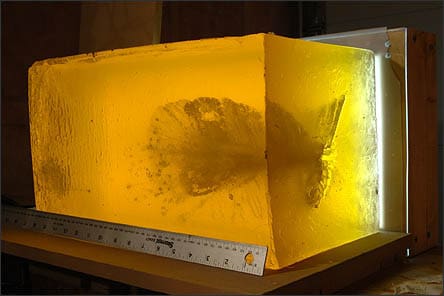
Perspective on the entrance holes and wound tract.
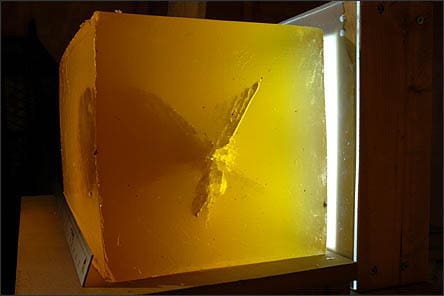
More perspective on the entrance hole.

Closeup of the entrance hole.
Tested was a 2¾ inch load of #2 Remington Express Birdshot fired from an 18 inch barreled Remington 870 Marine Magnum.
Small sized birdshot such as this #2 express load is a poor choice for deployment with a tactical shotgun. Wounds inflicted from birdshot tend to be gruesome yet shallow as they lack the penetration required to reach vital cardiovascular or central nervous system structures. For ultra close range applications (ie: inside your home) this load would likely be effective, however an operator should be prepared to follow up with larger shot in the event that additional force is required to stop a threat.
#1 Birdshot

2¾ Kent Tungsten Matrix #1 Birdshot
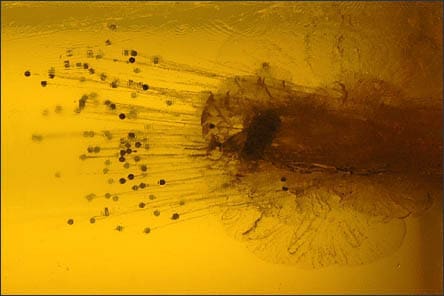
Closeup of the shot cloud and temporary stretch cavity.
The dark area on the right side of the photograph represents totally shredded gelatin.
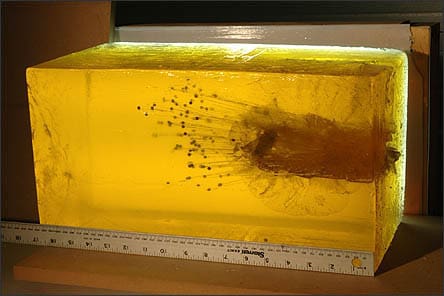
Slightly more perspective on the shallow yet massively shredded entrance tract.
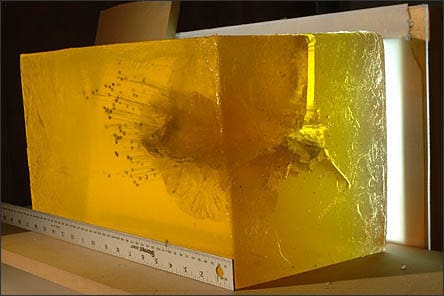
The three primary temporary stretch cavities were large; one tearing beyond the boundaries of our 9×9 test block.
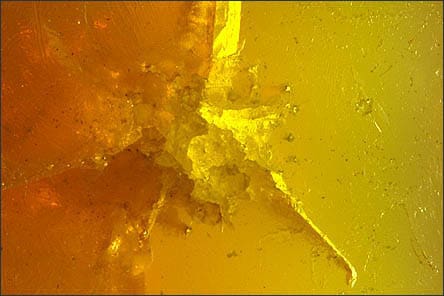
Closeup of the shredded gelatin at the entrance hole.
Designed as a better performing alternative to steel wetland bird loads, Tungsten Matrix is an exotic shotgun projectile material that has an even higher density than lead. It’s high density was what interested us in it’s possible application as a tactical shotgun load.
While approaching our minimum recommended penetration standard for an all around tactical shotgun load, this birdshot load just does not quite measure up. Consideration of this load should be limited to an application where an engagement is guaranteed to be very close range and overpenetration is a significant and unacceptable risk. In mitigating these risks it is important to recognize that birdshot loads are significantly handicapped as compared to buckshot loads in their capacity to create the deep permanent cavities required to damage either cardiovascular or CNS structures.
Lead BB
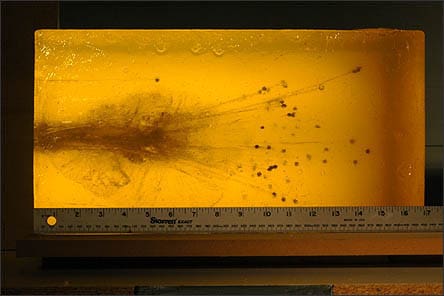
2¾ Remington Express Lead BB
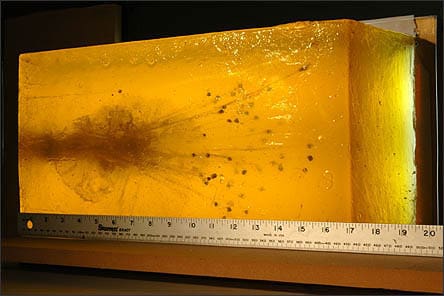
For close range applications possibly the perfect balance between pellet count and pellet size?
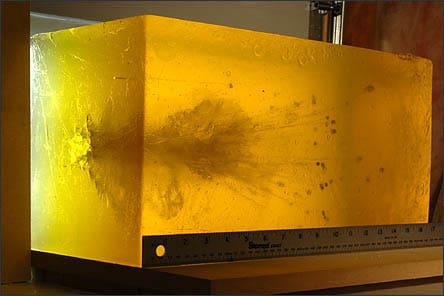
Aspect putting into perspective the entrance wound and the temporary stretch cavity tears
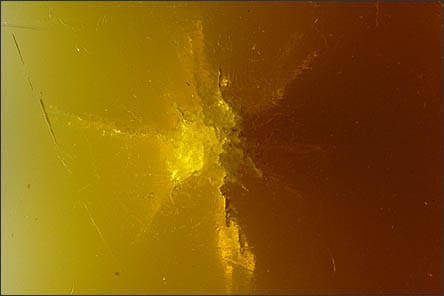
Entrance hole illustrating the 6 lobed temporary stretch cavity.
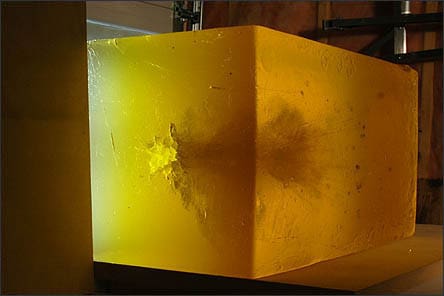
Large amounts of crushed tissue visible at the entrance wound extend approximately 6.5 inches into the block.
The entrance hole from the calibration bb is also visible.
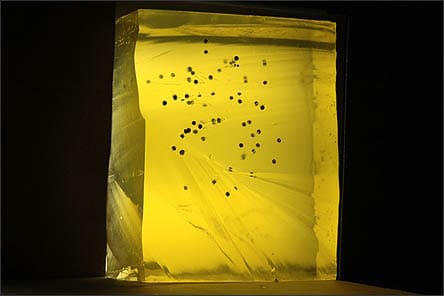
Cross section illustrating the spread of the shot as it travels through target media.
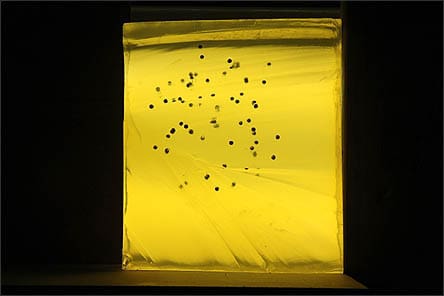
Cross section of shot cloud.
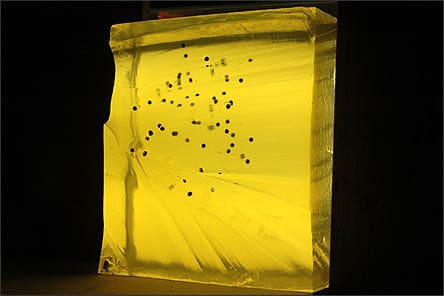
Cross section of shot cloud.
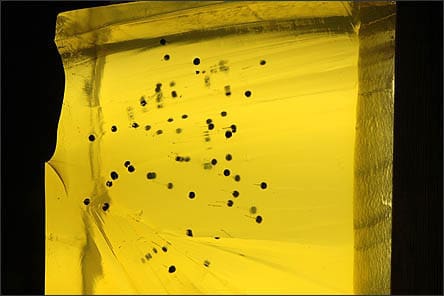
Closeup of the cross section. Visible are the individual wound channels created by the bbs.
Likely a very effective close range tactical load.
Before lead shot was banned throughout most of North America for use on waterfowl, Lead BB was the load of choice for long range goose hunting. The same performance characteristics that made it so well suited for that application merit consideration when evaluating short range loads for your tactical shotgun. We feel lead BB has it’s place, being a reasonable balance of penetration and pellet count. That being said, it is not recommended for medium range work. #4 buckshot is the minimum pellet size we recommend for general tactical applications.
#4 Buckshot

Federal Classic #4 buck shot out of an 18 inch barreled Remington 870 Marine Magnum. The shot column struck a little low…this photograph was taken without the ruler to show the entire shot load.

Temporary stretch cavity was approximately 10 inches long. Permanent crush cavities were on average 14.5 inches deep.
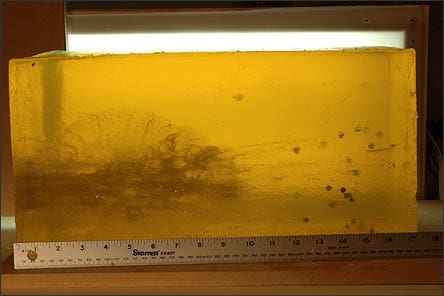
Generally…#4 buck is the minimum shot size we recommend for all purpose tactical applications.
Up for observation was a 2¾ inch load of federal classic #4 buckshot fired from an 18 inch barreled Remington 870 Marine Magnum.
#4 buckshot is what we here at [dead link] consider the minimum all purpose buckshot load for tactical applications. It balances decent penetration with a higher projectile count; increasing your first round hit probability over both #1 buck and 00 buck at medium shotgun range. If all pellets strike the intended target (likely when utilized at closer range) #4 buckshot offers several times the effective wound channel creation capabilities over both #1 and 00 buck.
#4 Buckshot Magnum
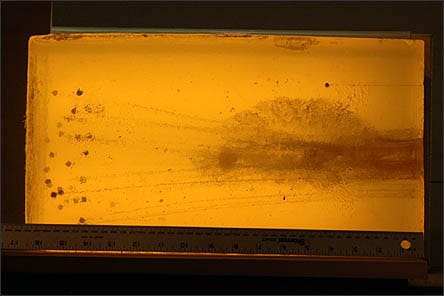
Federal Classic #4 plated magnum buck shot out of an 18 inch barreled Remington 870 Marine Magnum.
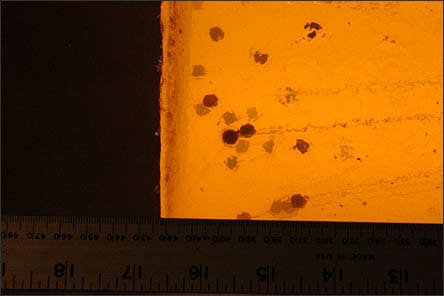
Impressive and consistent penetration of 15.5 inches was observed.
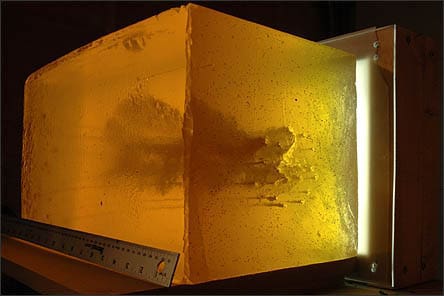
Perspective on the entrance holes and wound tract.
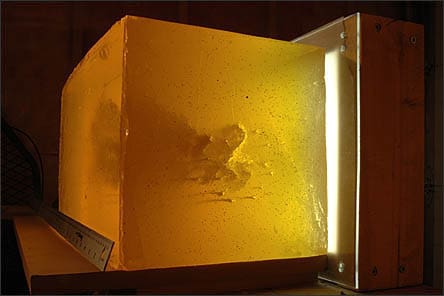
Given the 3 yard range, we were surprised the pattern had opened up as much as is evident in this photograph.

Closeup of the entrance holes.
Tested was a 2¾ inch load of federal premium #4 plated magnum buckshot fired from an 18 inch barreled Remington 870 Marine Magnum.
#4 buckshot is what we here at [dead link] consider the minimum all purpose buckshot load for tactical applications. While a standard #4 buck load typically has a payload of 27 pellets, this magnum load from federal has 34. Not a load for the recoil sensitive.
#1 Buckshot
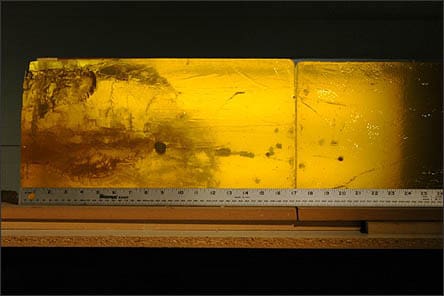
2¾ Remington #1 Buckshot (16 pellet) shot out of an 18 inch barreled Remington 870 marine magnum
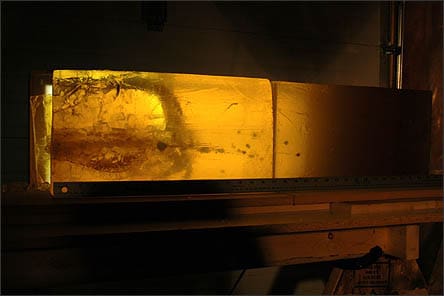
In this shot, the temporary stretch cavity exceeded the elastic limits of our gelatin block and ruptured out the top and side. An additional shot was conducted into a second gelatin block below at a slightly increased range to measure the temporary stretch cavity.
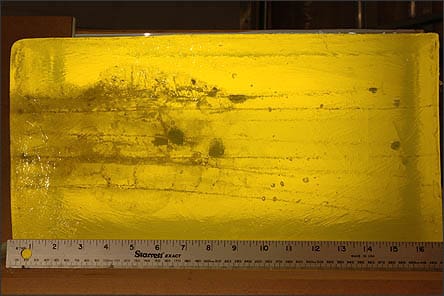
Overall penetration was approximately the same as the first shot, however the shot pattern was slightly larger at the 5 yard range as compared to the 3 yard range of the original shot.
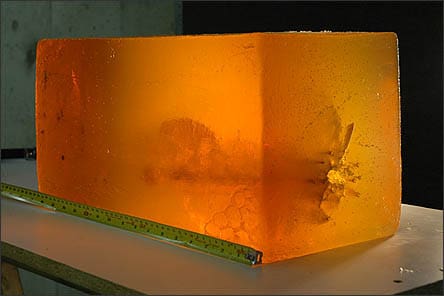
Perspective on the entrance wound of the 16 pellet load fired from 5 yards.
A 2¾ inch load firing 16 .30 cal pellets, this offering from Remington fired from an 18 inch barreled Remington 870 Marine Magnum exhibited excellent average penetration of approximately 16.5 inches. Temporary stretch cavity measured approximately 8.5 inches. Shot recovered exhibited minimal deformation.
In our opinion, this load is superior to 00 buck for selection as a tactical shotgun load. While exhibiting slightly less penetration, overall penetration is still acceptable and if all pellets strike their intended target there is potential to create approximately 77% more wound tract with the additional 7 pellets.
#00 Tactical Buckshot
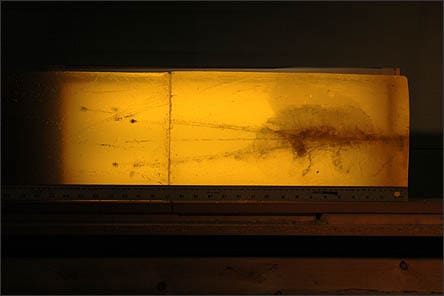
2¾ Remington Tactical Managed Recoil Buckshot (8 pellet) shot out of an 18 inch barreled Remington 870 marine magnum
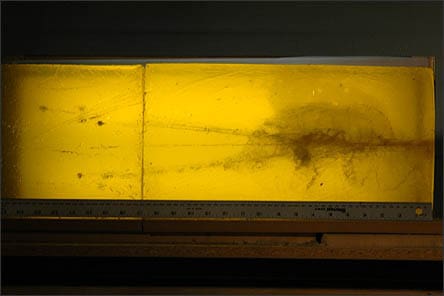
While this particular load patterned well in the test shotgun, surprising dispersion was noted in the gelatin media (one pellet was not even recovered). We speculate that is related to the moderate shot deformation observed in the pellets recovered.
This 2¾ inch load of Remington Tactical Managed Recoil 00 buckshot fired from an 18 inch barreled Remington 870 Marine Magnum surprised us with it’s considerable penetration of 20.5 inches. Temporary stretch cavity measured approximately 8.5 inches in length. Shot recovered exhibited some moderate deformation. The first 5 inches of the permanent crush cavities were all interconnected by tearing effected by temporary stretch.
Reduced recoil buckshot loads are becoming more and more popular they tend to pattern significantly tighter than the higher power loads in addition to being easier to shoot. Not as much a trade off in the penetration department as one might imagine, we would have no hesitations recommending this load for use in a defensive or tactical situation requiring buckshot.
#00 Buckshot (Federal Classic)
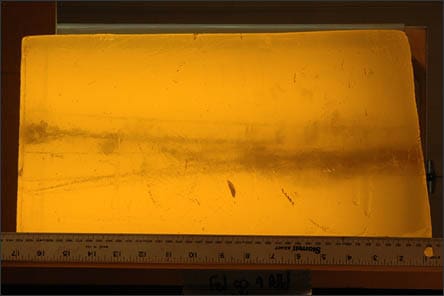
Complete penetration and generally tighter wound tract pattern.
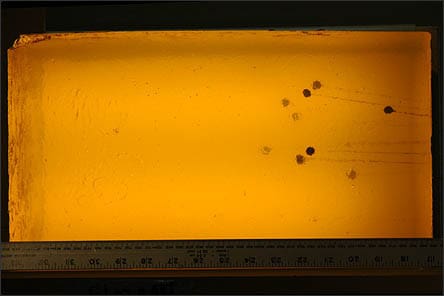
Block #2 illustrating the resting place of all 9 pellets.
As compared to the Remington express load the pellets exhibited approximately 50% less dispersion withing the target media.
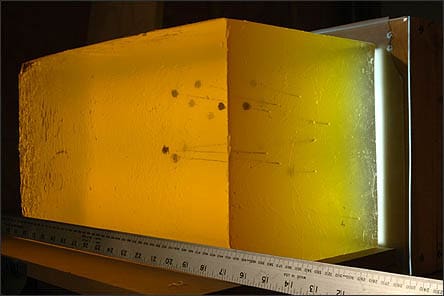
Perspective of Block #2
b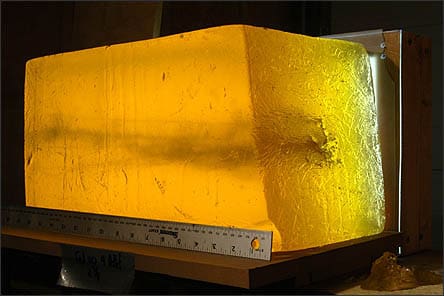
Perspective on the entrance hole and wound tract.
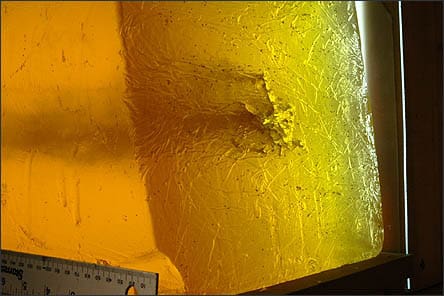
Closup of the entrance hole.
Tested was a 2¾ inch Federal Classic load of 00 buckshot (9 pellets) fired from an 18 inch barreled Remington 870 Marine Magnum.
As with most unplated buckshot, some mild deformation of the shot was observed. We believe most of this deformation occurs during firing, and plays a large role in how the shot will pattern. We do not believe general deformation of the hardened lead pellets is significant with respect their performance in target media. We do believe federal’s wad configuration is superior to most others, and as a result most of their buckshot loads tend to pattern tighter than those of their competition. Patterning can vary greatly from shotgun to shotgun….the only way to know how your shotgun will perform with any given load combination is to get out and pattern it yourself. With our caveat out of the way, we will state that it has been our observation that federal buckshot loads typically pattern tightly across a large variety of different shotguns.
#00 Buckshot (Remington Express)

Composite photograph illustrating total penetration of one round of Remington Express 00 unplated buckshot.
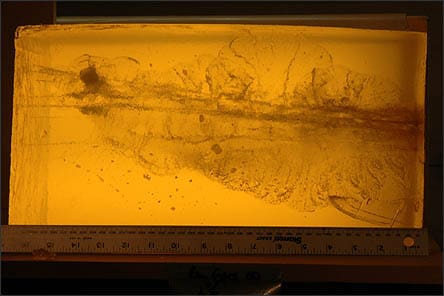
The first block illustrating the temporary stretch cavity and the dispersion of the shot within the target media.
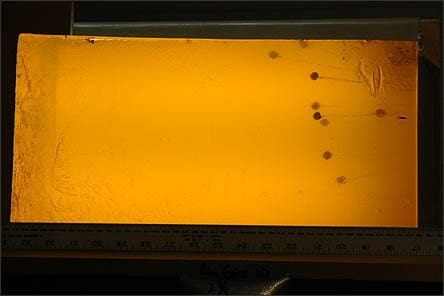
Relatively uniform penetration of all 9 pellets was observed.
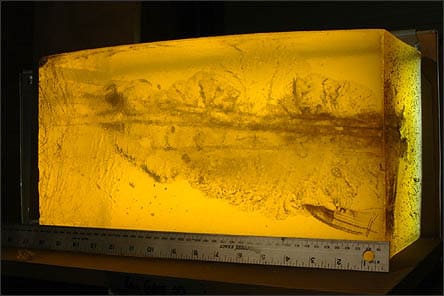
Perspective on the entrance hole and wound tract.
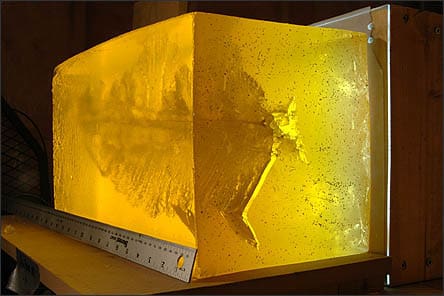
More perspective on the entrance hole.
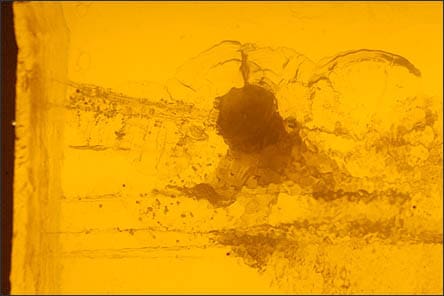
Closeup of the wad at it’s resting place in the first block.
Tested was a 2¾ inch Remington Express load of 00 buckshot (9 pellets) fired from an 18 inch barreled Remington 870 Marine Magnum.
As with most unplated buckshot, some mild deformation of the shot was observed. We believe most of this deformation occurs during firing, and plays a large role in how the shot will pattern. We do not believe general deformation of the hardened lead pellets is significant with respect their performance in target media.
#00 Buckshot (Federal Classic Magnum)
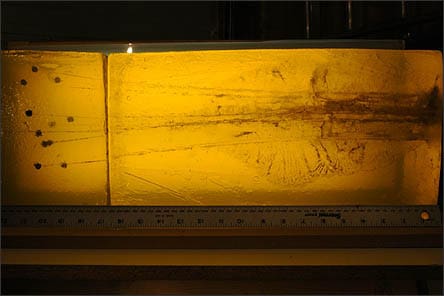
2¾ Federal 00 Buck Magnum (12 pellet) shot out of an 18 inch barreled Remington 870 marine magnum
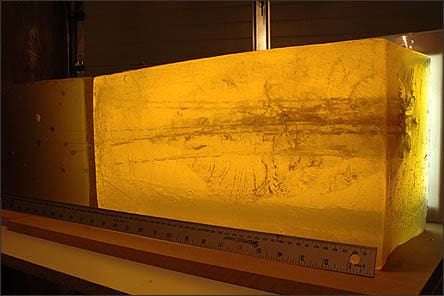
Details of the large temporary stretch cavity and the entrance aspect.
The temporary stretch cavity measured approximately 11 inches in length
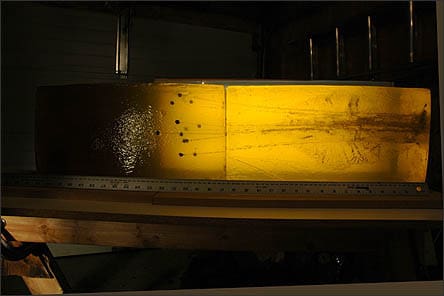
Wider perspective of testing rig. 2 blocks of gelatin, each 17 inches long, were used for this test.
Up for observation was a 2¾ inch magnum load of federal 00 buckshot fired from an 18 inch barreled Remington 870 Marine Magnum. Considerable penetration on average of 20 inches was noted, with the temporary stretch cavity measuring approximately 11 inches. Shot recovered exhibited minimal deformation and we speculate this is due to both buffering and the unique wad configuration of this particular load. The first 6 inches of the permanent crush cavities were all interconnected by tearing effected by temporary stretch.
If excessive penetration is not an issue, performance as observed in this test would likely be strong in a tactical application.
Reduced Recoil Slug

2¾ Remington Reduced Recoil 1oz Slug shot out of an 18 inch barreled Remington 870 marine magnum
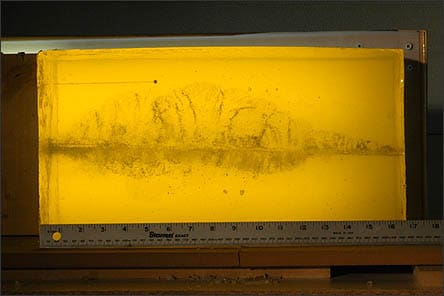
Total penetration of the load was longer than our gelatin photographing light fixture. As a result we photographed each block separately and spliced the two together for the first photograph. Here is a photo of the first block.
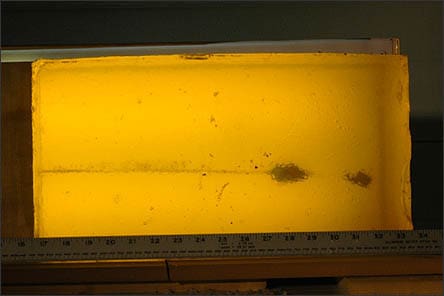
The second gelatin block showing the slug and wad material.
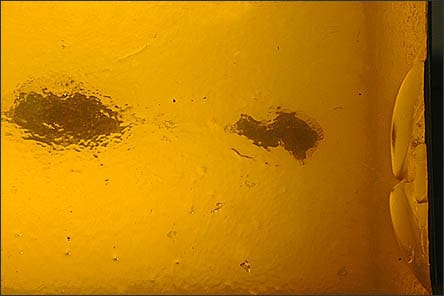
Closeup of the slug. You can how it has yawed slightly, however the proximity and similar orientation of the wad suggesting that tumbling of the slug is unlikely as it travels through the target media.
Because the slug is as wide as it is tall, it is difficult to determine tumbling via examination of the permanent wound channel.
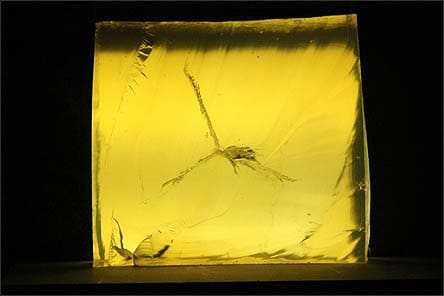
Cross section of the 1st gelatin block approximately 8.5 inches in. Visible are the large tears of the temporary stretch cavity.

Slight perspective on the cross section.

Closeup of the 3 lobed tears.
Wow! If you can live with the approximate 15 to 20 yard decrease in maximum range (85 yards as compared to approximately 100 with a full power slug), this load exhibits phenomenal penetrating capability…especially when you consider the projectile’s poor sectional density.
Reduced Recoil Slug (14″ Barrel)

2¾ Remington Reduced Recoil 1oz Slug shot out of a 14 inch barreled Remington 870 hybrid. Our light table is not long enough to capture the full tract, thus the composite photograph.
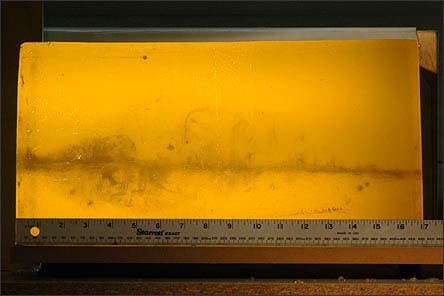
As with most slug testing, total penetration of the load was longer than our gelatin photographing light fixture. As a result we photographed each block separately and spliced the two together for the first photograph. Here is a photo of the first block.
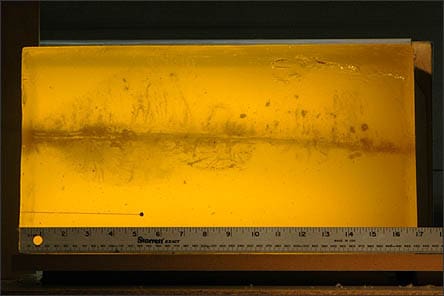
The first block rotated 90 degrees, illustrating with slightly more clarity the temporary stretch cavity.
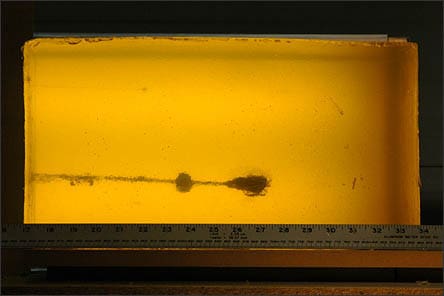
The second gelatin block showing the slug and wad material. In comparison to the same load fired out of an 18 inch barreled remington 870, the 4 inches of barrel length missing effects an overall penetration reduction of approximately 2.5 inches.
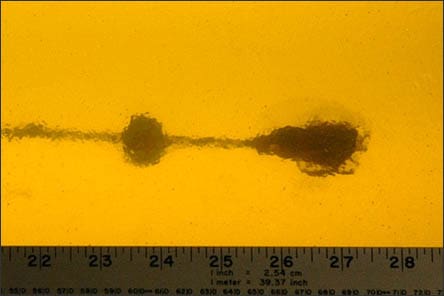
Closeup of the slug….in this case the cardboard wadding wound up pressed into the back of the slug.
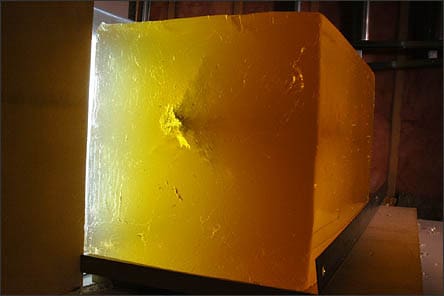
Perspective on the entrance hole.
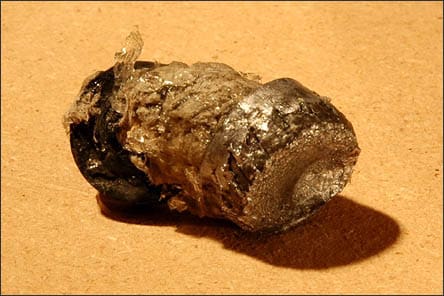
The slug and wad combination extracted from the gelatin.
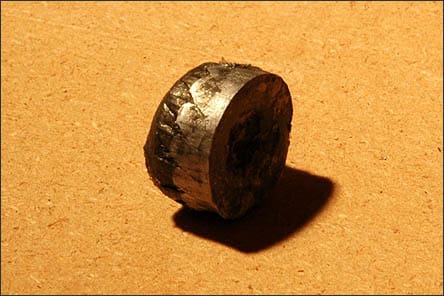
Closeup of the recovered slug.
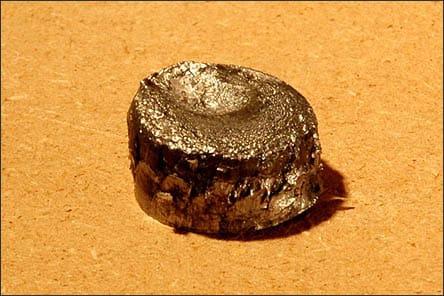
Evidence of the slightly lower muzzle velocity when fired from a barrel 4 inches shorter than our standard 18 inch test barrel is approximately 2.5 inches of total penetration reduction. Are the benefits of the reduced recoil slug and a short barreled shotgun worth this type of performance penalty? Our experience has been that on animals weighing less than 500 lbs there is nothing lacking at all in this slug/barrel length combination.
We highly recommend reduced recoil slugs, as they certainly are easier on the shoulder in practice and as such you are likely to practice more and feel more confident in your ability to hit. In our patterning exercises we also found these slugs to be very accurate across a wide variety of guns.
****NOTE**** Based on experience with a yearling cow we were requested by it’s owner to shoot, we DO NOT RECOMMEND REDUCED RECOIL SLUGS FOR DANGEROUS GAME OR ANIMALS THAT WEIGH MORE THAN 500lbs.
Foster Slug
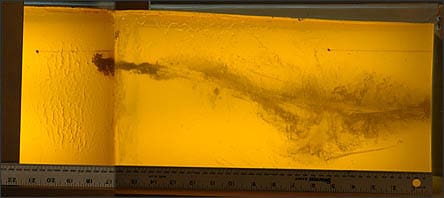
Composite photograph illustrating total penetration of a 1600fps Winchester foster styled slug.
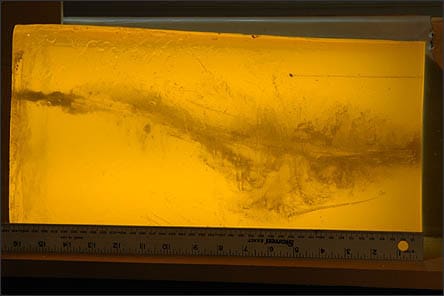
This photograph illustrates the deflection of the slug as it traveled through the target media…likely caused by the high degree of slug deformation observed.
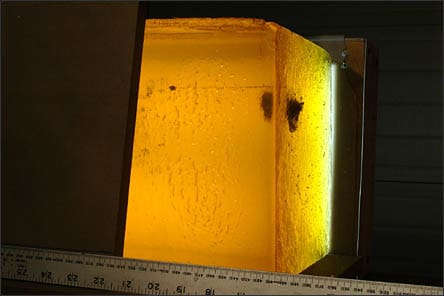
The slug only barely penetrated into the second block.
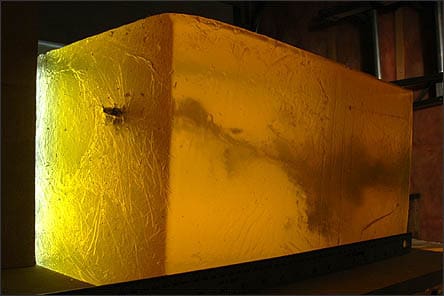
A fragment of the slug was recovered at the very tail of the first block.
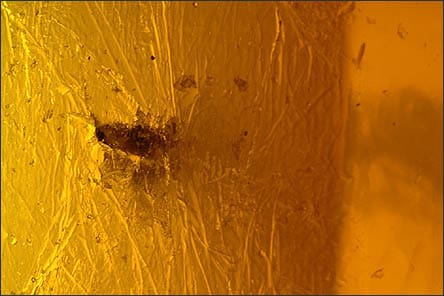
Closeup of fragment and exit hole in the first block.
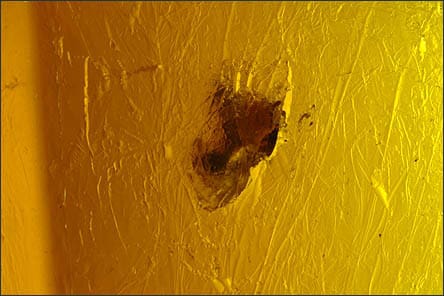
Closeup of remaining slug…only about an inch into the second block.
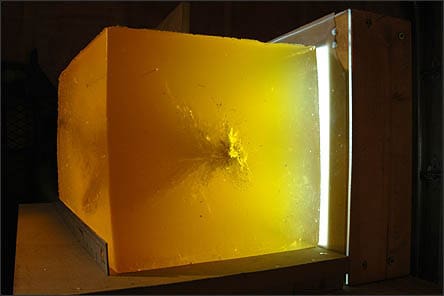
Perspective on the entrance hole.
Tested was a 2¾ inch Winchester regular foster styled slug fired from an 18 inch barreled Remington 870 Marine Magnum.
A 1 oz soft lead slug blazing out at approximately 1600 fps yielded some surprising observations in our ordinance gelatin. What makes the results surprising is when they are compared with those of the reduced recoil loads; the higher velocity of the regular loads (such as this one by Winchester) produce less penetration as far more energy is invested in deformation and deflection of the slug.
Brenneke R10 Slug
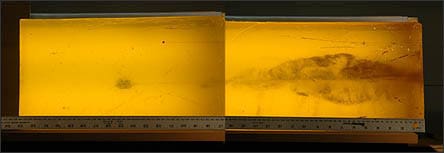
Composited combined tracts of a 2¾ Brenneke R10 slug fired from an 18 inch barreled Remington 870 Marine Magnum.
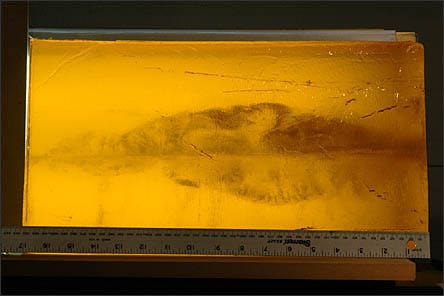
As with most of our slug testing, total penetration of the load was longer than our gelatin photographing light fixture. As a result we photographed each block separately and spliced the two together for the first photograph. Here is a photo of the first block.
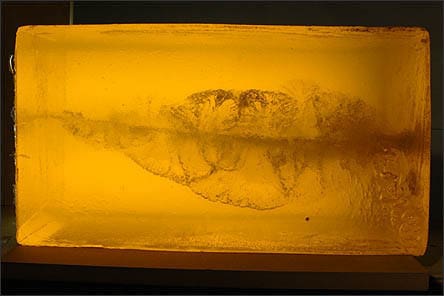
Rotating the block to emphasis the temporary stretch cavity, note that it is significantly more developed and longer as compared to the regular foster style slugs we’ve tested.
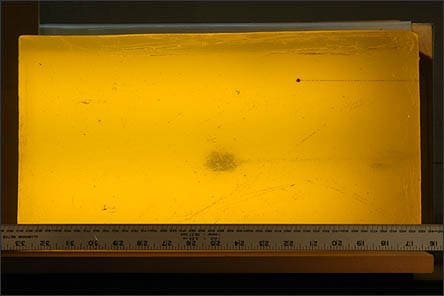
The second gelatin block showing the slug and affixed wad.
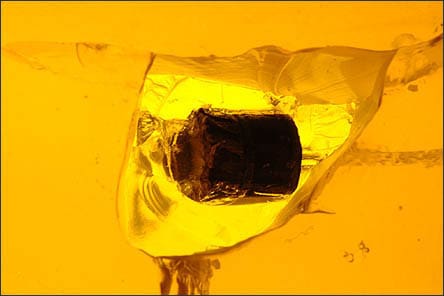
Exposing the slug.
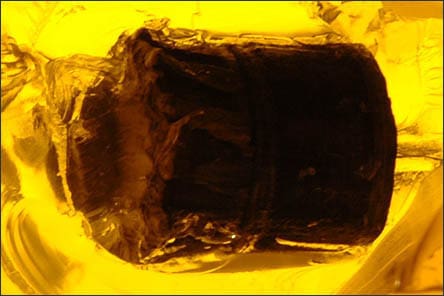
Slug detail.
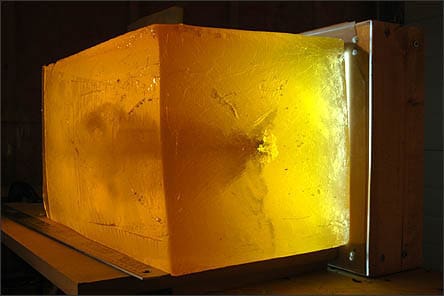
Perspective on entrance.
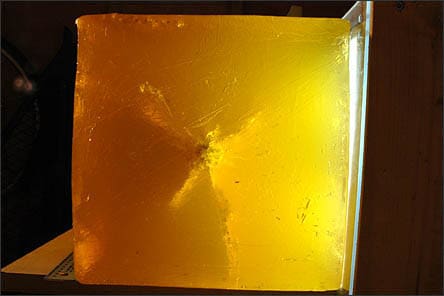
Entrance hole.
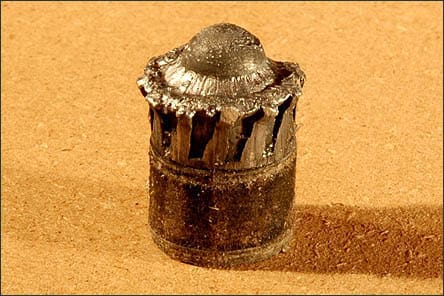
Slug and wad combination as recovered from the gelatin.
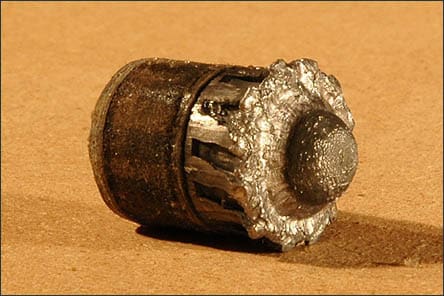
Significant expansion of the slug at it’s head.
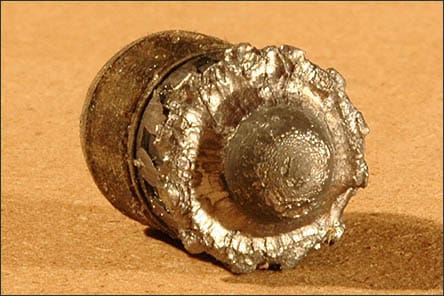
Detailed photograph of expanded slug head.
Brenneke slugs are frequently discussed as having significantly superior penetration characteristics as compared to other high velocity slugs. Our gelatin testing support these claims and uncovers some other interesting performance characteristics that merit consideration when selecting a slug.
The nose design of these slugs is such that very controlled expansion occurs with the slug retaining 97% of it’s original mass. The slight expansion and geometry of the expanded head are such that as the slug travels through target media it cuts a larger diameter wound tract. As compared to most regular foster styled slugs cast/swagged from soft lead, the brennekes are manufactured from a harder alloy that largely accounts for the slug holding together better at the higher velocities.
When pushed in the neighborhood of 1600 fps, the softer lead slugs tend to deform significantly; losing their penetrating potential as the slug either expands so much as to present huge cross sectional area or breaks up into smaller, less efficient fragments. As the brennekes hold together better, they are a more appropriate slug when deep penetration in dangerous game is required.
International Frangible Slug

2¾ International Frangible slug fired from an 18 inch barreled Remington 870 Marine Magnum.
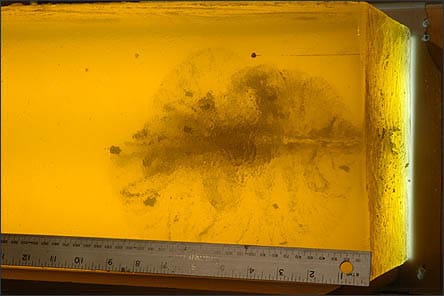
Primarily designed as a non lead training round with minimal ricochet or spatter potential, these rounds are designed to disintegrate on impact.
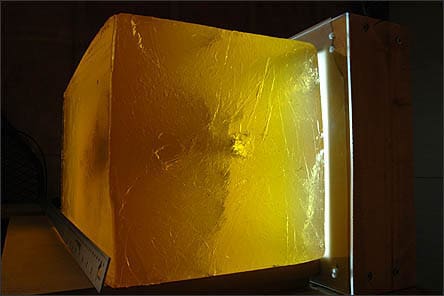
Perspective on the entrance hole.

Closeup of the entrance hole.
Likely an excellent load for those concerned with over-penetration in a crowded urban environment while still needing the relative accuracy associated with a single projectile, we’d have no reservations endorsing this load as a medium range precision 12 gauge round.
This being said, poor penetration characteristics of the slug should be taken into serious consideration.




I want to follow your advice that #1 buck is a great tradeoff between safe home defense and adequate penetration. I want to switch to it from 00 buck and slugs, but the stores around here as well as all websites I can find only sell 0 buck, I cannot find #1. You did not test 0 buck (13 pellet), but do you think it would be a better defense round than a slug or 00buck for the house? Thank you.
I CANNOT FIND #0BK ANYWHERE.PLEASE SOMEONE HELP ME LOCATE #0BK.
The original post was 8 years ago. Why do you need #0 buck instead of #1? I use #1, #2 magnum and #3 rounds, depending on the use. For home defense, I use the #2 magnum. 18 Hardened, copper-plated .27 caliber pellets per round. 1 round chambered, 5 in magazine. I use a 20 gauge youth pump shotgun, due to medical complications.
20 gauge is all that’s needed, Heck I have a 870 28 gauge Express that came with a Mod. Choke fixed 25″ inch barrel. I sent the barrel of to Briley for tubes and thread cut for REMCHOKE. Got another 25″ inch Express barrel while I was waiting on Briley. Cut it to 20″ inches making it Cylinder cut bore and I threaded the vent rib for the original 6×48 TPI bead and replaced it with a Trijicon front shotgun Bead. Originally I had the gun to hunt with as I have neck injury that makes repeated 12 gauge Dove hunting a folly and fools game. 3/4 oz magically is the weight of 16 #4 Buckshot or 13/16 oz magically is the weight of 15 #3 Buckshot pellets. I simply cut the wad petals off Federal 28 gauge plastic wads and load to weight data for 3/4 or 13/16 oz load data. Works Great.
I found it sometime ago using ammo.com. It is #0 12 pellet at 1275 fps. from Remington. Glad I bought a bunch.
I would love to see real world penetration tests on Dixie Slugs 3 inch IXL-DGS (Dangerous Game Slug) .730″ and is a hard cast and heat-treated 870 grs slug at 1200′ from a 20″ barrel. There is nothing on the internet I have found or youtube showing this round’s capabilities. I have found nothing else like it and so would love to see actual testing of this ammo! Especially compare it against against other major manufacturers “dangerous game slugs”! It would seem to be an ideal round for bear defense in Alaska.
I too would like to see gelatin tests on the Dixie Slugs 3 inch IXL-DGS (Dangerous Game Slug). This would likely be the most powerful and deepest penetrating commercial shotgun round.
The 12 gauge 3 inch Dixie TriBall Buckshot round is another exceptional round I would like to see gelatin tests performed on. This round consists of three massive 60 caliber hard cast lead buckshot pellets weighing 315 grains each. This choke friendly load would make great defensive round against large predators.
I found the Brenneke slug test of great interest. Myself I've taken a wild boar at 75 yards with the RWS Rottweil 12 gauge 2 3/4 inch classic slug with the felt wad. The terminal effect was a complete through and through of the heart/lungs area. Animal fell right there, was demised in less than one minute. I had six inches of drop to contend with, and using a fixed rear sight, this was a little bit of a test of my shooting skills.
One shot was all that I needed. I have complete & total confidence for use against any big game in North America with this German made slug.
I have kept my Wingmaster riot gun loaded down with Winchester #1 buck for some time. Patterns well from 20″ cylinder bore barrell and from all I’ve read ,seems to have a slight edge over 00 buck for home defense duty. That being said ,I would hate to be on the business end of any riot gun slinging any size buckshot.
While you don’t evaluate tungsten matrix BB, you do test tungsten matrix #1 birdshot and lead BB. Your test made me more comfortable with my choice of Remington HD Ultimate Home Defense BB (the HD is for high density tungsten matrix composition) shotshells for home defense in an urban environment.
Why not test #3 and #2 buck as well? Then all sizes would be covered. #2 is the largest size that can be used with a 20 gauge and #3 is a step up from #4. I know #2 and #3 are definitely available for the 20 ga, not sure about the 12 though. I use #2 magnum in my 20 ga for home invasion defense.
Actually true #1 is the largest that 20 gauge can handle with Fiber Wad loads. Normally Magnum is 12 pellet 2 3/4″ inch 20 gauge load using fiber wads or older Remington SP20 or RP20 wads with petals removed………wad acts as gas seal and cushion only then. 9 pellet #1 Buck is loaded by several Euro companies and PMC used to offer both 9 pellet #1 and 12 pellet #1 for 20 gauge. Long time ago long long ago Winchester and Remington offered both 20 gauge #1 Buck 9 pellet and Magnum 12 pellet loads, slow as piss though in 12 pellet. Stacks in groups of 2 pellets on top of 2 pellets for 12 pellet loads or even 8 pellet #1 Buckshot 20 gauge loads.
I’ve had good luck loading #1 buck from my 20-gauge shotgun. All I do is purchase regular birdshot hunting ammo and replace it with #1 buck placing two buck side by side for 5 rows. They give a fairly tight pattern, much tighter than the Rio #1 buck.
Nice test. I would like to see the test done at a range of five feet, and with full choked guns. Most people have a modified or full choked shotgun, and defense ranges inside of houses are often very close.
Clearly, even the smallest common bird shot, #8 and 7 1/2 are deadly at most indoors distances. They may not be optimum choices, but they are hardly as harmless as many have suggested.
You need targeted traffic to your Shotgun Penetration With Various Rounds – The Truth About Guns website so why not get some for free? There is a VERY POWERFUL and POPULAR company out there who now lets you try their traffic service for 7 days free of charge. I am so glad they opened their traffic system back up to the public! Check it out here: http://kbbl.ir/4y
Definitely consider that which you said. Your favorite reason appeared to be on the
internet the easiest thing to take into account of.
I say to you, I definitely get annoyed whilst other people consider concerns that they plainly do not know about.
You controlled to hit the nail upon the top and defined out the entire thing with no need
side effect , folks can take a signal. Will likely be back to get more.
Thanks
yes bird shot can hurt how ever i recomend utbe video rounds of authority 4 a comprehensive perspective analysis
check out videos about ooobuckshot
I have a 12 ga. Mossburger 500 18″ barrel. What is my range of fire with OO Buck Ammo? Respectfully yours, Anthony
Penis
Very nice test! Shotgun can do a lot of damage on a short distance!
What’s up,I check your new stuff named “Shotgun Penetration With Various Rounds – The Truth About Guns” like every week.Your humoristic style is awesome, keep it up! And you can look our website about proxy list.
I’m a former high-crime-area Police Detective and have seen the results of birdshot and OOB on human targets (none fired by me).
Case #1: Bad Guy wearing thin shirt was sitting in the driver seat of car with door open and feet on the sidewalk pavement facing shooter. Shooter shot him 3x with full size 20 ga pump loaded with birdshot (can’t remember what size shot but holes looked very small like # 7 1/2). First two shots knocked Bad Guy down on seat but he got right back up. 3rd shot did the same but this time subject stayed down. All 3 shots fired from 10y and all centered on chest. Bad Guy survived.
Case #2: Stake-out cop shot armed robber from 10y with 20″ 12ga loaded with OOB. Bad Guy was turning towards cop with pistol in hand and OOB impacted his upper right arm between elbow and shoulder, the OOB pellets penetrated arm and entered upper chest, none exited body. Robber staggered several steps sideways, tripped over liquor display and fell. He died about 2 minutes later as I was lifting up his mask to see who he was.
My conclusion: Subjet hit with birdshot could have returned fire for sure after shot #1 if he had gun already in hand and maybe even after shot #2. The subject hit with OOB was instantly disabled and was unable to return fire even though he had pistol in hand.
Interesting observations. My only reservation is the use of a 20 ga in the first instance- this may have made a difference but who knows. I do know that high base 12 ga birdshot #5 or #6 will kill at close range in the body or even moderate distance when struck in the head, as I have seen the police reports or heard from others in my investigations as an insurance investigator. That is why I always were orange clothing when upland bird hunting now. I do keep #5 high base birdshot for my home defense shotgun due to wall penetration concerns.
Since I live a quarter mile through thick woods from any neighbors, I keep my H&R pump 20 youth model loaded with #2 magnum rounds. 18 plated .27 cal pellets, buffered with grex (ground plastic).
Birdshot smaller then Lead #BB is junk for people unless it’s all you have at the instant of an attack.
My only accidental discharge in my life was with a 20 gauge REM. 1100LT-20 26″ inch barrel full choke in the gun firing Winchester XX Supreme 1 1/8 oz #4 Magnum load. I had mad a bad mistake but that’s a story for another day. When the gun went off I had it pointed down at an angle facing a double door closet. The shot impacted at the base of the closet back wall hitting an old set of bed frame rails / Steel sheet metal bed rails about 1/64″ of an inch thick very thin stuff. Not one #4 Copper plated pellet penetrated the rail and the entire load deflected at an angle into the drywall harmlessly just sticking in it. It’s junk for SD in all but the closet 3-9 feet instances and with direct perfect head, neck, or heart hits. More often then not it does not stop or work out as intended.
Hell I watched a Turkey once at 10-15 yards take a full 12 gauge 1 7/8 oz #6 load to the body and neck area and fly away like nothing happened. Probably shooter error and only some pellets hit him but still that’s the point it’s not got the penetration to do much unless perfectly done right. To much room for error and mistakes. Besides any load will go through 2-3 layers of drywall with enough power to injure a person or blind them so using small birdshot sizes accomplishes nothing other then mental security……….it’s just a binki for the brain. Look up the % of people hit on accident in SD shootings by shotguns from over penetration or shots that went through walls…………….it’s nearly impossible to even find a single case on the internet little alone in Police reports.
As to the #0 buck guy asking about it. All Modern factory American #00 buckshot is not real .340 caliber #00 pellets inside the shells…………it’s usually .330 Caliber or .328 Caliber with some companies like Hornady using .320 caliber which is actually #0 Buckshot lol…………they just call it #00 to make you feel big and good 🙂 When Winchester in the 60’s went to using a Teflon Type Shot Wrap called Mark-5 and Fiber Base wads rather then cork the shell internal space was less. They went from using .340 caliber to .330 caliber #00 and called it such. Federal changed to a plastic wad and thus started using .328 caliber roughly or .330 pellets. Remington was the only company to stay with true .340 caliber #00 and some Euro Companies like Wolf load it .340 Caliber.
Remington is also the only company to offer true #1 Buckshot .30 caliber balls inside. Winchester uses a plastic shot cup inside it’s 16 pellet #1 Buckshot load after they changed from using the Mark-5 wrap in the 80’s. This required them to reduce the size of the #1 Buckshot pellet from .300 caliber or .298 to a smaller .285 caliber projectile more like #2 1/2 Buckshot. Federal’s Flite Control uses #2 Buckshot .270 caliber but calls it #1 thus the 15 pellet count rather then 16 as true or close to true #1Buck .30 caliber stacks in 4 pellet layers. The only flite Control that uses close to true size #00 pellets is the Federal 8 Pellet Loads and it’s .330.
#0 Buckshot is and always has been .320 caliber True and loaded only by Remington in 12 pellet 1295 FPS load listing using Fiber Wads and buffer. It’s very over looked but rocks on the pattern board as it’s stacked in 3 pellet layers kinda loose inside the buffer and it can be loaded into shotcups snug fit……….to date most manufacture wont offer #0 Buckshot as all there fancy shotcup loaded #00 loads are using .320 – .330 sized pellets inside rather then true .340 caliber #00
so, im buying up on sellier & bellot 2/3/4″ #1bk.cant find remengton #0bk anywhere.is this s&b #1bk what it says?
Has anyone tried the Nobel or Aguila mini-shells, or the new Federal mini shells?
I would personally like to see patterns with the buckshot mini shells at 5, 7, and 10 yards, to cover the home-defense distances for which they seem to be intended.
Then I want to see ballistic gelatin tests. Calibrated 10% gelatin covered with four layers of heavy 16 ounce cotton canvas denim. Shoot from five yards. How deep do the pellets penetrate? What can we expect in terms of performance? Are they adequate or should we stick with conventional 2 3/4″ buckshot?
Comments are closed.